Sutina Area Cleanup Successfully held by Sinj Tourist Board (PHOTOS)
April 4, 2022 - The Sutina area cleanup was held by the Sinj Tourist Board on Sunday, April 3.
To mark World Water Day, the Sinj Tourist Board, in cooperation with NOPD Koćari and with the support of the City of Sinj, the Split-Dalmatia County Tourist Board, and the participation of many volunteers and members of mountaineering societies Svilaja and Vukovi - Sinj, Cetina adventure club, Croatian Mountain Service Rescue Sinj, JU More i Krš, cycling club Vlaji -Sinj, and DVD Sinj, held an ecological action on April 3 to clean, arrange, and mark the existing trails in the Sutina area.
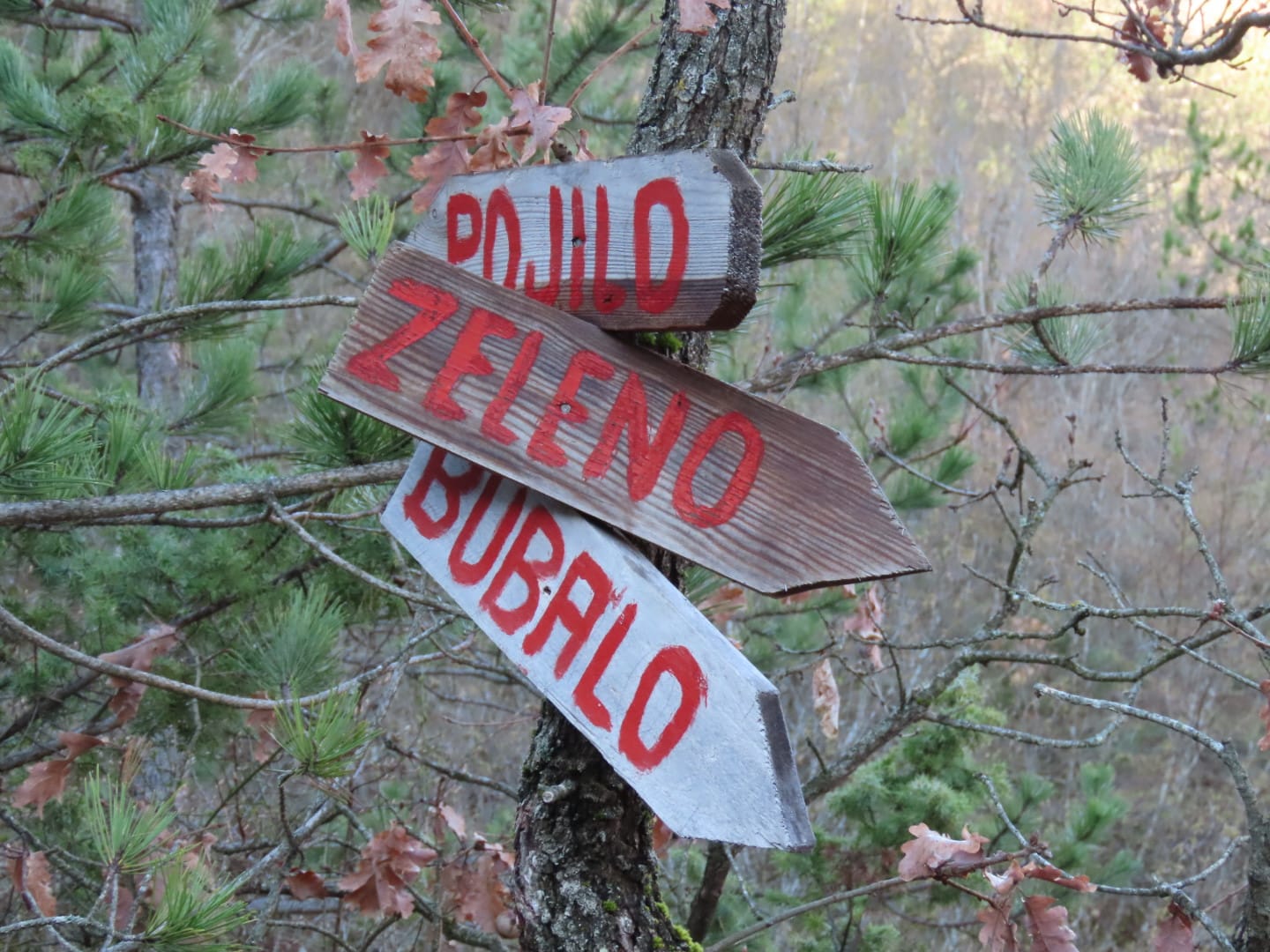
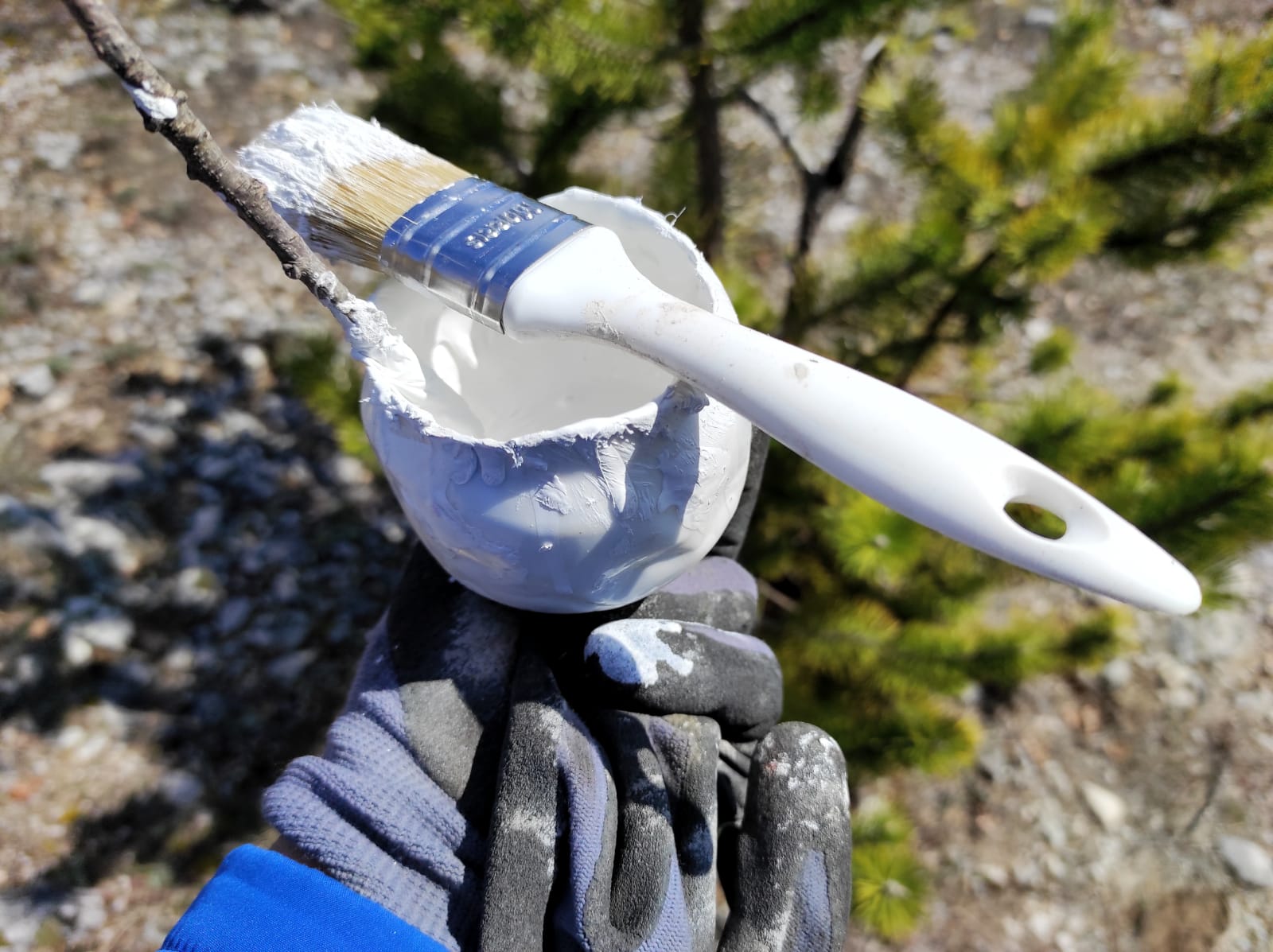
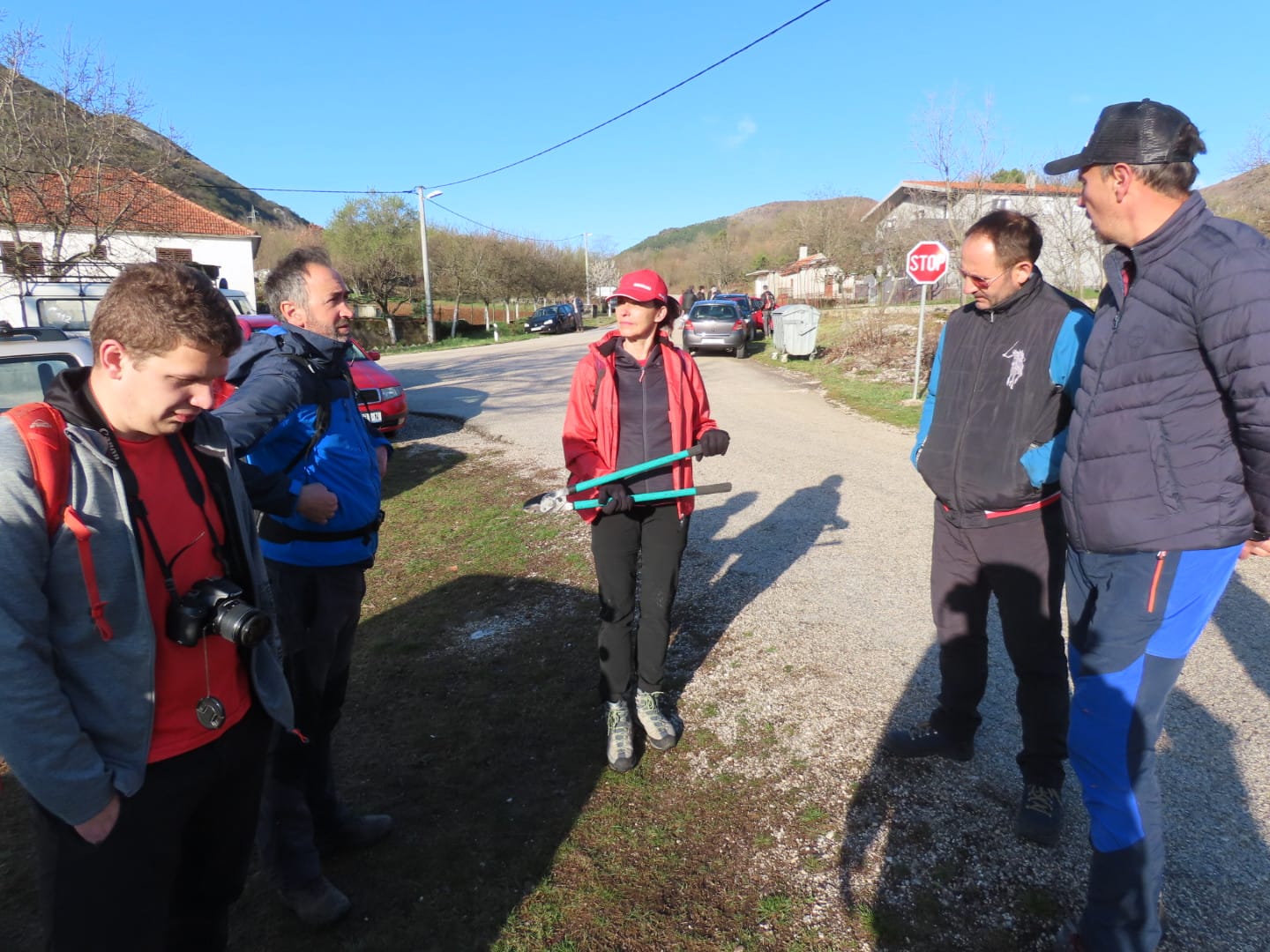
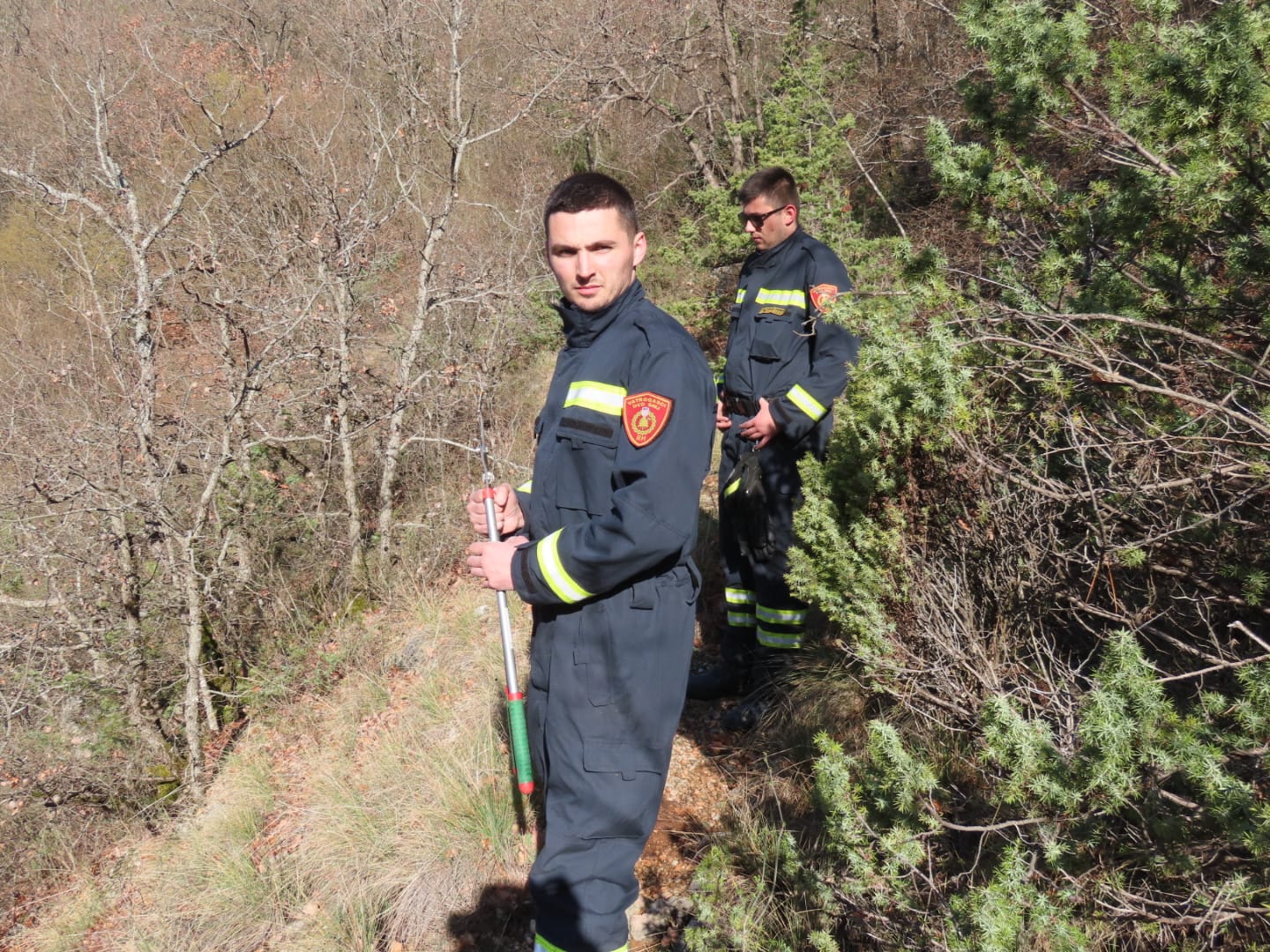

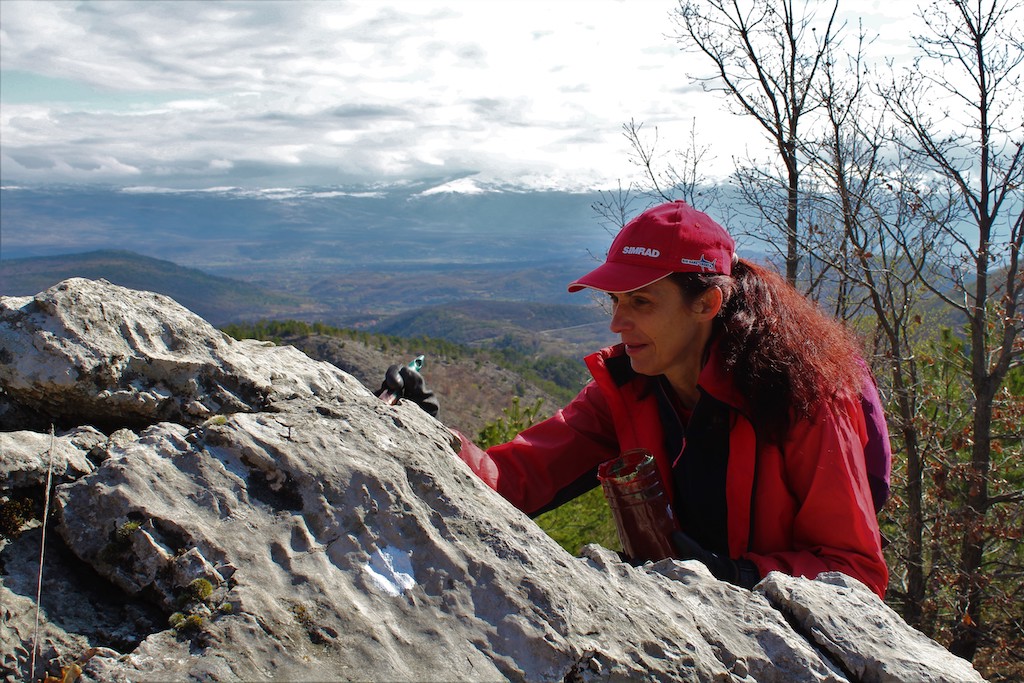
The action was originally planned for April 2, but due to bad weather conditions, it was postponed and held on April 3.
The Sinj Tourist Board thanks all nature lovers who selflessly joined this event!
Photos by Željko Zrnčić, Marko Glavinić, Nikica Ugrin and Monika Vrgoč.
Hack4Split: Social Hackathon Being Held in Split This Weekend
April 4, 2022 - This weekend, on April 9 and 10, organized by the Entrepreneurship Center Split and the Student Entrepreneurship Incubator of the Faculty of Economics, a social hackathon Hack4Split will be held: a two-day competition aimed at solving social problems and designing social innovations
This weekend, on April 9 and 10, the social hackathon Hack4Split will be held in the SPINIT incubator, reports Tportal.hr. It is a two-day competition aimed at solving social problems and designing social innovations. It brings together individuals with specific knowledge, regardless of education and occupation, who find solutions to problems in their local community, in line with the UN's Sustainable Development Goals.
The competition aims to encourage young people to become active members of their community, to get acquainted with the needs and problems in their community and environment, and engage in solving them.
This year's edition will be attended by 52 participants in 10 teams who will develop ideas such as an application for recognizing marine organisms, facilitating afforestation to absorb CO2 emissions, safe houses for victims of violence, applications for solving long waiting lists in hospitals and more. Participants will have 24 hours to develop a prototype of their solution in the form of products or services, followed by a presentation of all developed projects.
During the hackathon, participants will have at their disposal mentoring support, and there will also be a workshop entitled 'Is e-mail marketing dead?'. Apart from the hackathon participants, the workshop is also open to the public and will be held by Martina Šepić, director of Webpower Adria. You can apply to participate in the workshop via this link.
The best teams can expect various useful prizes, such as the SmartNinja course 'Programming for Beginners: Python', online training of your choice from Mirakul Education Center, a voucher for ZIP Line Split, free one-month use of The Works coworking space, and money for further development. The organization of the hackathon was sponsored by Dobar tek, Wolt, ZIP Line Split, SmartNinja Hrvatska, Mirakul education center, OTP banka dd, The Daltonist Craft Bar, The Works Coworking, and Nova Eurospectra.
The hackathon is organized by the Entrepreneurship Center Split and the Student Entrepreneurship Incubator of the Faculty of Economics in Split in partnership with Ensoco, Digital Nomad Association Croatia, and Split Tech City. The hackathon is part of a project funded by the European Solidarity Force of the European Union and the Central State Office for Demography and Youth.
For more, check out our lifestyle section.
More Tourists in Non-Commercial Accommodation in Croatia Last Year
April 4, 2022 - In 2021, there were 466.2 thousand tourists in houses, apartments, and holiday homes or non-commercial accommodation in Croatia, 2.3 percent more than in 2020, while the number of overnight stays was 9.3 percent or 10.1 million less, according to the Central Bureau of Statistics (CBS).
Owners of non-commercial accommodation in Croatia pay a tourist tax as a lump sum and are obliged to register themselves and all persons who spend the night in the house or apartment (family members, relatives, friends) in the eVisitor tourist check-in and check-out system of the Croatian National Tourist Board (CNTB), from which the CBS takes data on non-commercial tourist traffic and continues to process them statistically.
Locals came less and spent the night in houses and holiday apartments
According to these data, out of the total turnover in non-commercial accommodation in 2021, almost 76 percent of arrivals and 56.4 percent of overnight stays refer to foreigners, who came to this type of accommodation 5 percent more than in 2020 (353.1 thousand) but realized 3 percent fewer overnight stays (5.7 million), reports Index.hr.
Croatian citizens also realized fewer overnight stays in non-commercial accommodation than in 2020, by 16 percent (4.4 million), and according to reports in eVisitor, 5 percent fewer came to that accommodation (113.1 thousand).
Last year, 37,000 Slovenians came to this type of accommodation, totaling 2.6 million overnight stays. According to that, they were by far the most numerous and the most overnight stays in houses and holiday apartments in Croatia among all tourists from other nations who were in that type of accommodation.
They were followed by Germans and tourists from Bosnia and Herzegovina with 640 thousand and 634 thousand overnight stays, and among the first ten countries, whose tourists realized one hundred thousand and more overnight stays in that accommodation: the markets of Serbia, Austria, Czech Republic, Hungary, Poland, Italy, and Slovakia.
Zadar County and Kvarner with the most non-commercial overnight stays
In the research on this traffic, CBS did not provide comparisons of traffic from these and other markets in non-commercial accommodation in Croatia from 2020, which is not stated for individual counties, but only data on arrivals and overnight stays for 2021. Zadar County, with 36 percent of all overnight stays in that type of accommodation, ranks in the first place.
The second is Primorje-Gorski Kotar with 26 percent of total overnight stays, while the third is Istria with 15 percent of total overnight stays in non-commercial accommodation.
They are followed by Šibenik-Knin County, where 8.2 percent of overnight stays in non-commercial accommodation were realized in holiday homes and apartments in 2021. Split-Dalmatia County follows with almost 7 percent of overnight stays, and Dubrovnik-Neretva County with 4.4 percent, while Lika-Senjska County with the lowest share of 4 percent in total overnight stays.
However, not all other counties in Croatia have that much, because the share of overnight stays in non-commercial accommodation was only 0.2 percent.
What the CBS does not yet state in this research is the number of houses, apartments, and holiday apartments (accommodation units, etc.) in which this non-commercial tourist traffic was recorded in 2021, and they note that the quality of research results is significantly affected by the discipline of check-in and check-out the stay of persons in non-commercial accommodation facilities and the work of inspection bodies that monitor this phenomenon.
For more on travel in Croatia, follow TCN's dedicated page.
Croatia Has Taken in 11,974 Ukrainian Refugees So Far
4 April 2022 - Since 25 February, 11,974 Ukrainian refugees have arrived in Croatia, and most of them are in individual accommodation, the government said at its website dedicated to the Ukraine crisis.
Of the arrivals, 5,832 or 48.7% are women, 1,619 or 13.5% are men and 4,523 or 37.8% are children.
Most of them are staying in individual accommodation, 1,498 are in collective accommodation and 16 in private accommodation.
The Civil Protection Directorate has mobilised 34 facilities for collective accommodation, three reception centres, and one catering and one transport company to provide for the refugees.
According to UNHCR, by the end of March more than 10.5 million people were displaced internally in Ukraine or left the country as refugees, which is around one quarter of the country's population. The UN agency estimates a total of 13 million people in Ukraine urgently need humanitarian assistance.
"Biblical" Bird Invasion Devastates Slavonian Fields, Farmers Desperate
April the 4th, 2022 - There is a plague of birds that is biblical in a way taking place over the rich Slavonian fields, with farmers and others in the agriculture sector scratching their heads as to what to do. All common means of deterring the birds are failing, and some are ready to start killing them.
As Poslovni Dnevnik writes, Slavonian farmer Darko Grivicic painfully stated that he feels as if he's walking around in a desert, and not in the usually rich and fertile Slavonian fields.
He sowed an ecological feast last autumn, and now his fields look like the Sahara, reports HRT. All of what he planted has been destroyed and eaten by wild geese and cranes, and there is devastation on all sides. The problem this year, according to Darko, is even bigger because of climate change. Darko's field isn't the only one that was ravaged by wild geese. Berislav Stefancic from Radovanje has had around 50 hectares of young crops consumed by birds.
The birds are omnivorous
“These are mostly omnivorous birds, except for the grey wild goose, which is a herbivore. At the pond, they have a good feeding ground as far as fish, snakes and frogs are concerned, and here is their salad in our fields. They eat mainly winter crops - wheat rapeseed oil and the like. We haven't sown those in this area for the last two years because the damage they cause is terrible,'' said Berislav.
Wild geese come because there are huge fishponds in nearby Oriovac, and an ornithological reserve for spoonbills has been declared there. From year to year, said Iva Ivezic from nearby Radovanje, more and more of these birds come, meaning that the damage to these crops is increasing.
"Every year the problem is getting worse and every time I come to the same question - These birds are protected, but who is working to protect us? This year, an extremely large number of birds have appeared that we can't seem to deter or stop. We can't see how we can solve this problem,'' emphasised Iva.
Farmers on duty, firecrackers, drones - nothing helps
Local farmers have tried everything they can imagine, testifies Josip Culetic from Slavonski Kobas, who has had about 70 percent of his crops eaten by birds. Scarecrows, farmers on duty, he's tried everything. He says that one can be on duty out in the Slavonian fields for 23 hours per day, and when you go home for lunch, the birds arrive and do their damage in the span of just five minutes.
"We've chased them away with drones, but the birds only moved within a kilometre or two. It's a viscious circle, they don’t give up at all. At one point, they gathered and headed for the drone, trying to attack it. They aren't stupid,'' added Berislav Stefancic.
Darko Grivicic added that they threw around a million firecrackers and rockets trying to drive away the birds, but they failed even with that harsher measure. Darko went a step further. For about 20 thousand kuna, he bought and deployed 11 gas cannons, but it didn't help much. He believes that these tenacious birds would get used to even 30,000 cannons.
“When we sow grain, they immediately land and take out the seeds. We put out the scarecrow, we come and stand around, and they're brazenly standing on the scarecrows. They have become immune to all our measures,'' added Iva Ivezic.
Local hunting associations are also powerless because hunting protected birds is prohibited, with the penalties for doing so being absolutely astronomical. Whoever kills such a bird pays a fine of up to 30 thousand kunas Darko Grivicic said that the situation is unsustainable, and so far, the birds have eaten 3 million kuna out of his pocket.
Some are already sick of the damage and are ready to poison the birds
Some local farmers are losing patience. Darko Grivicic testified that people are increasingly threatening to bring poison in from Bosnia, mix it with cereal and corn and scatter it across Slavonian fields.
"Facirol is an agent that can be mixed well into corn or grain and then scattered on the roads. I believe all the geese and cranes would die if they consumed it. The only question is where they die. If they die in the ponds, they'll probably poison the resident fish as well. If someone catches that fish and takes it home there is a possibility that we end up accidentally poisoning people. But it has to be said that this is an option that some people are ready for, if nothing is done,'' claims Darko.
Slavonian farmers are now busy working on and announcing millions of lawsuits against the state that they claim is doing absolutely nothing to protect its own food producers.
For more, check out our lifestyle section.
Two Palaces in Zadar Will Host Croatian Modern Art From July
April 4, 2022 - TCN met Dina Bušić, the city of Zadar's head of culture. She explained the new project Two Palaces in Zadar, which will host the best exhibitions of Croatian Modern Art from July.
The City of Zadar has finally found a solution for the future of the Two Palaces: starting from July this year, the artworks from the National Museum of Modern Art in Zagreb will move into the premises of the Proveditor and Rector's Palaces. With this Agreement of Cooperation signed by the City of Zadar, the Ministry of Culture and Media, and the National Museum of Modern Art, Zadar has become a new centre of modern art in Croatia.
The way to achieve this result has been paved by Dina Bušić, the city's head of culture. She’s confident that thanks to this enormous renewal commitment, Zadar will be rediscovered for its archaeological history, tourism, it’s architectural treasures such as the well-known Greeting to the Sun and the Sea Organ, and eventually as a centre for Croatian modern art.

Image: Bosnic / Dorotic
Dina Bušić, could you please give our readers a brief history of the Rector's and Proveditor's palaces?
For centuries Rector's and Proveditor's palaces were the centre of secular power in Zadar and Dalmatia. The construction was done in stages: Rector's Palace was built during the Middle Ages and instead Proveditor's Palace in the late Renaissance. The buildings have undergone numerous adaptations over time. Although architecturally connected and with a similar purpose, they remained functionally separated until 1870, when under Austrian rule, they were bound and arranged for the new administrative complex of the Zadar Government.
The Rector's Palace is located in the western part of the Two Palaces complex, and it is the oldest building. It was first mentioned in historical documents in 1288 as the gathering place of the city council of the independent medieval municipality of the city of Zadar. Under Venetian administration, the city duke was housed here. In the 17th century, the Proveditor's Palace was added on the east side. The year 1607 is engraved in an inscription on the façade. The General Proveditor of Dalmatia and Albania was in a higher grade than all city princes and captains and resided in Zadar as this was the capital and the most important port on the eastern Adriatic coast.
What were the purposes of these 2 palaces before the Homeland War? Which institutions and cultural bodies operate within the Palaces?
After 1920, when Zadar passed under the Italian administration with the Treaty of Rapallo, the complex lost its former purpose. No practical purpose was found until the end of the Second World War when it became the site of various cultural institutions of the city of Zadar, so the people of Zadar called it the House of Culture. The City Library, the Blagoje Bersa Music School, the Croatian Singing Music Society Petar Zoranić, and Radio Zadar were located on the complex premises. At one moment, the Registry Office was also located here, where many Zadar residents got married.
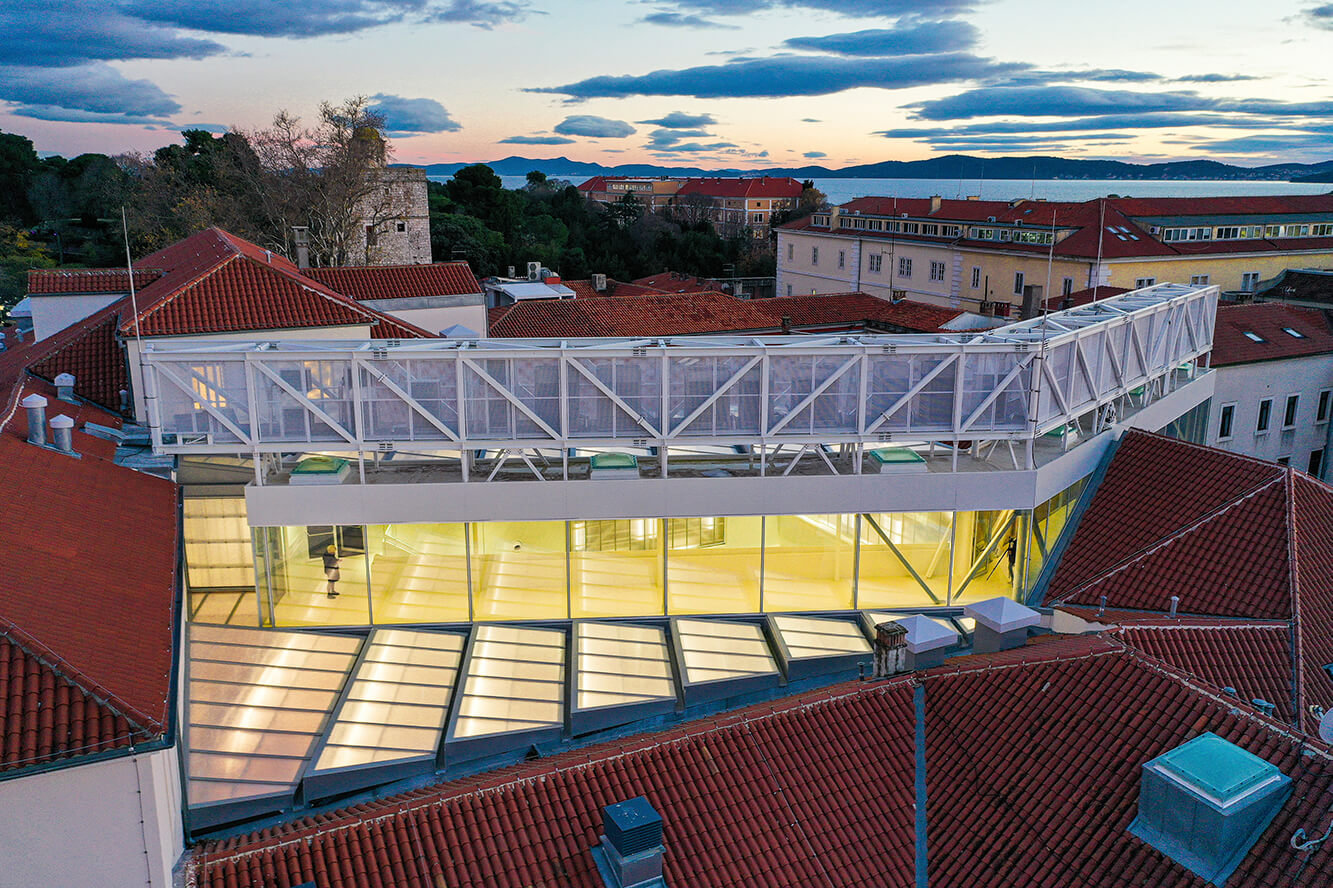
Image: Filip Brala
How were the Palaces damaged during the Homeland War?
These two palaces suffered enormous damage during the Homeland War. Several cannon shells hit the north and west wings of the Rector's Palace and the south wing of the Proveditor's Palace. The bombing raids that affected the palaces occurred in late 1991 and early 1992. A large part of the roof was destroyed, and the statics of the Rector's Palace was damaged, and the structure suffered severe deformations. The building was declared unusable.
The Great and Small Concert Halls of the Blagoje Bersa Music School and the Croatian Singing Music Society Petar Zoranić Hall were destroyed in the Rector's Palace. Also, all the musical instruments that were in these halls were destroyed. The city library was not affected but suffered significant damage to its rooms and inventory. The multimedia centre of Radio Zadar was hit, and the technical equipment was damaged.
When the renovation began, first the Rector's and then the Proveditor's Palace, who financed the reconstruction and designed the connection and the renovation of the Two Palaces?
The first reconstruction works started during the war - back in 1993. The Conservation Department in Zadar began collecting documentation and conducting an onsite inspection of the first floor of the Rector's Palace. In 1999, extensive exploration, dismantling, and cleaning work developed a consolidation and complete renovation project. At the Rector's Palace, for the first time in Zadar, a new method called "pulling the wall" was used, consisting of an iron rope to bring back the sloping north wall to a vertical position.
The renovation of the Rector's Palace was fully completed through a project funded by the EU Structural Funds for 2007-2013. The renovation and touristic valorisation of the cultural and touristic complex of the Rector's Palace began on October 2nd, 2014, and ended on September 30th, 2016. The project coordinator was the City of Zadar, and the implementing partners were the National Museum of Zadar, the Zadar Tourist Board, the Zadar County Development Agency - ZADRAnova, and the University of Zadar.
After the renovation of the Rector's Palace, the City of Zadar continued with further investments in strategic infrastructural facilities of cultural heritage through the ZADAR HERITAGE project, which was co-financed under the Operational Program "Competitiveness and Cohesion" 2014-2020.
Renovation and connection of the palaces in the complex Two Palaces as a single unit were carried out based on a project developed by Iva Letilović and Igor Pedišić, which through a bold and attractive solution of the so-called snake, united the space of two palaces.
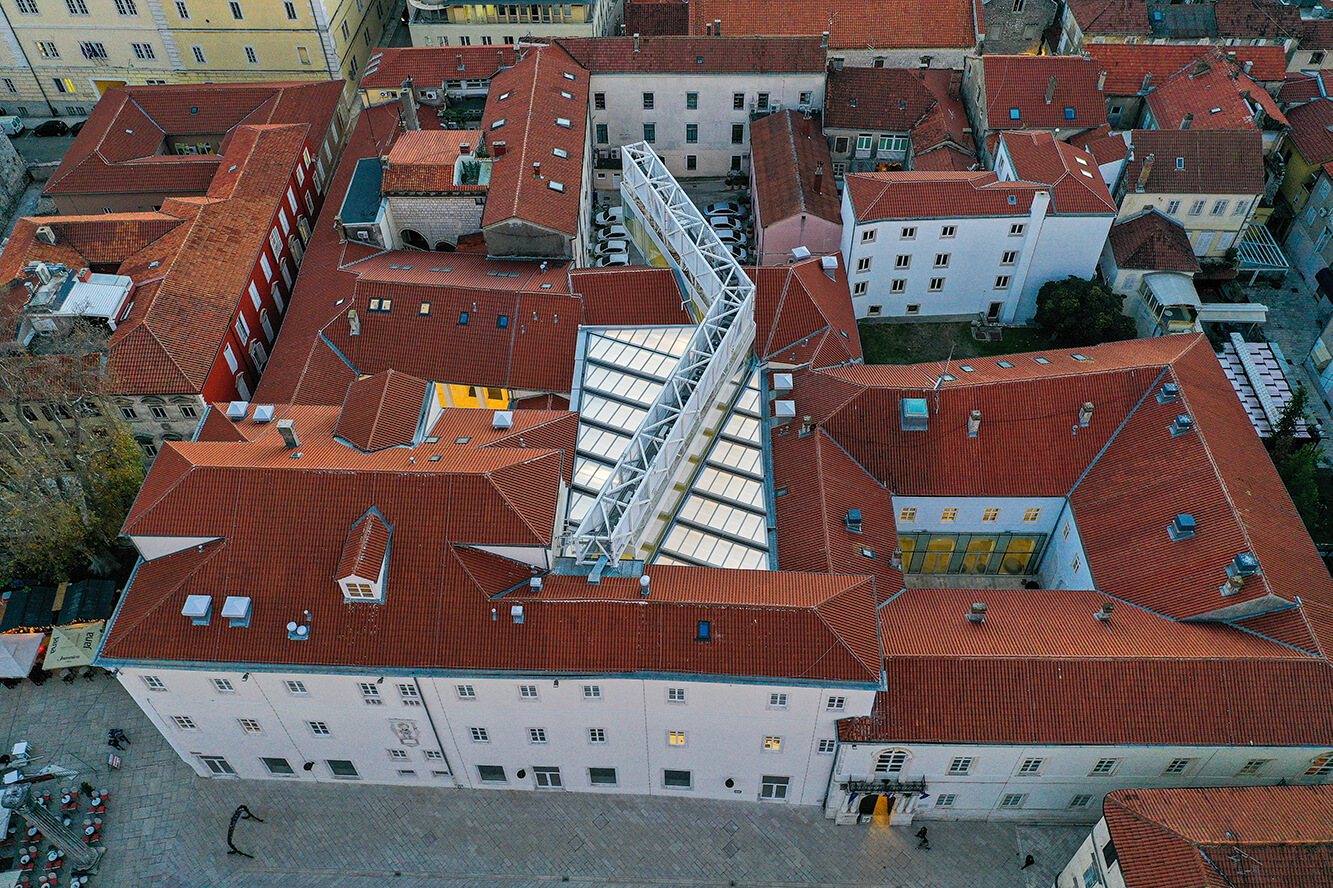
Image: Filip Brala
What is the purpose of the two palaces after the renovation, what are the contents, and how much will it mean for Zadar to enrich the cultural life and promote Zadar on the cultural map of Europe?
The Two Palaces complex is intended as a central place in maintaining the cultural life of Zadar with exhibitions, concerts, dance and theatre performances, film screenings during festivals, conferences, receptions, and other events from the cultural and social life of Zadar.
On the ground floor of the building, all the spaces and halls can serve as museum facilities, such as a museum shop, a reading room, an educational workshop, an entrance area, a cloakroom, and a space for catering activities. On the first and second floors, the halls for the permanent exhibition were reconstructed and arranged. On the third floor, closed halls were reconstructed and arranged.
What does the cooperation of the Two palaces with the National Museum of Modern Art (NMMU) mean?
NMMU is one of the collaborators of the Two Palaces, in the same way as the Zadar National Museum, with which we nurture long-term cooperation within the Rector's Palace. Namely, there was a unique opportunity through which we, in collaboration with the director of NMMU, Branko Franceschi, crystallised the idea of the decentralisation of national artistic treasures.
It means that they will find a second home here in Zadar and that we will have the greatest works of the late 19th and 20th centuries from Croatia here available to everyone in a precious art space. I am convinced that having our Croatian national art in the heart of Zadar is one of the best experiences that visitors can have and that with this approach, we will open the door to a whole new series of collaborations.
When can we expect the first exhibition?
We will soon hold a press conference and present a detailed program. We will open on April 20th with a rich program of arts, music, books, and films. In ten days, The Two Palaces will offer more than thirty events. Stay tuned, and all be welcome!
Lifestyle: For more, check out our lifestyle section
Croatian Fuel Prices to Finally Drop Tomorrow - Here's the New Prices
April the 4th, 2022 - Croatian fuel prices should be finally set to drop tomorrow after last week's hike which came as a very unwelcome surprise to drivers.
As Poslovni Dnevnik writes, following on from last week's significant and entirely unwelcome increase in Croatian fuel prices, there's finally a little bit of good news for the nation's drivers. From tomorrow on, Croatian fuel prices will be lower, but they will still not be able to compensate for the increase from last week.
As such, the prices of regulated Eurodiesel in Croatia should be about 80 cents lower, while Eurosuper 95 petrol should be about 35 cents cheaper. This means that one litre of Eurodiesel should cost around 12.70 kuna, while a litre of Eurosuper should cost around 12.10 kuna. There was a significant rise in Croatian fuel prices last week. Petrol rose in price by 61 lipa, and diesel did the same by as much as 1.48 kuna, 24sata writes.
Anonymous activists announced that last night, some fuel stations here in the City of Zagreb had stickers with the image of Prime Minister Andrej Plenkovic stuck on them, as well as a derogatory message.
"We're aware that the growth of Croatian fuel prices is being influenced by many factors, but also Andrej Plenkovic's government has not done everything it could have to curb the rage in prices. They reduced VAT on some energy sources, but they didn't do the same with fuel, just as they didn't reduce excise duties as much as they could have, but only by a miserable 20-40 lipa. We demand a stronger reaction from the government, a reduction in levies and greater relief. We'll continue this action over the coming days when we intend to present ourselves to the public,'' the group of activists called the Boys and Girls of Zagreb's Asphalt ", 24sata writes.
For more, make sure to check out our lifestyle section.
Ryanair Rijeka Flights Canceled, Passengers Stranded at Airport
April 4, 2022 - Ryanair Rijeka flights were canceled on Sunday without any e-mail notification or other possibilities for passengers at Rijeka Airport. A look into what happened.
On Sunday, Rijeka Airport announced three Ryanair return flights from Charleroi, London, and Stockholm. However, only the plane from Stockholm landed and took off from Rijeka airport, and the other two flights were canceled, reports Croatian Aviation.
Due to the strong wind in Rijeka on Sunday morning, flights to London and Brussels were canceled, which in itself would not be news if the problem did not arise in communication between the airline and passengers.
Namely, several passengers who were supposed to travel from Rijeka to Charleroi Airport saw that their flight was canceled. And due to the strong wind at Rijeka Airport, the Ryanair plane landed at Pula Airport instead of Krk.
At 11 am, the plane took off from Pula for Rijeka, where it was supposed to land, pick up passengers for Brussels and, with a two-hour delay, bring them to their destination in Belgium. As the wind did not calm down, the plane flew back to Charleroi without the Rijeka passengers.
About 30 passengers awaited the arrival of the plane at Rijeka Airport, and according to information from the airport, they were informed that, in the worst case, if the plane fails to reach Rijeka, they will be transported by bus to Pula and go to their planned destination from there. In the end, neither happened - Rijeka passengers did not go to Pula, and Ryanair's plane eventually failed to land in Rijeka.
Only a little later, the same story happened with the Ryanair flight between London and Rijeka. Due to the wind, the plane diverted to Pula and then took off from Pula to Stansted Airport without the passengers in Rijeka.
According to EU Regulation 261/2004, in case of flight cancellation due to bad weather conditions, passengers are not entitled to compensation but have the right to care, refund, and be redirected under similar conditions to the earliest flight to the planned destination. As Ryanair's next flight from Rijeka to Charleroi is only on April 7, passengers will probably make their trip from nearby airports, Zagreb and Zadar, from where Ryanair also operates to the airport.
However, the passengers did not receive any notification via e-mail about the flight cancellation and other possibilities, or that an additional flight from Rijeka was mentioned on Monday to transport passengers to their destinations, which was an information error.
As all this happened due to force majeure. Ryanair made the best option for itself as an airline - it canceled flights for which it knows it will not have to pay a fee of 250 euros per passenger and offered passengers the next direct flight, which is a business move. Passengers could still be transported from Rijeka by bus to Pula, from where they would travel to their destinations on the same day with a certain delay, but Ryanair did not do so due to additional costs, and above all not to jeopardize the implementation of its other scheduled flights on Sunday with just those planes.
For more, check out our travel section.
Varazdin Ekos Holding Among Most Stable Croatian Companies
April the 4th, 2022 - The Varazdin Ekos Holding company is among the ranks of the most stable Croatian companies despite the state having more or less totally ''forgotten about them'', according to its founder.
As Jutarnji/Novac writes, the Varazdin Ekos holding, one of the most stable Croatian companies, is now under new management. The founder and man who brought Ekos Holding to the wholesale confectionery throne, Hrvoje Vojvoda, once the mayor of Varazdin, has been replaced by his son Josip, and the biggest changes they faced took place in Ekos pekarnica, the most important daughter company of Ekos, holding a 75 percent share in their revenue.
Last year ended with 100.2 million kuna in revenue, the year before with 80 million kuna, and the Varazdin Ekos Holding company is growing year by year.
Josip Vojvoda has always surrounded himself with women in business. Much like his father, the other bosses who had been building the company since 1990 have now also retired. The new president had to elect some new people. He appointed only four women to the management of the Ekos bakery, all of them under the age of 40, and Josip is convinced that these new bosses are the best for a new, more modern Ekos Holding.
Ekos recently embarked on a major challenge, the construction of a modern plant in the neighbouring county of Medjimurje.
''Six thousand tonnes of cakes come out of Ekos every year, and with this new plant, that number will be three times higher. From back in 2012 until today, the company has been growing steadily, the confectionery part is our core business and we can all be happy here that we're engaged in this business. Confectionery is the pinnacle of every food industry and always brings something new with it, it also brings what is old is back into fashion, but in some sort of new version. We've shown ourselves good in overcoming new challenges,'' stated Josip Vojvoda.
He is young, just 38 years old, is married to wife Zeljka, who is also employed by Ekos, and has two daughters, Eva (10) and Vita (2). He has a degree in economics and grew up within the Varazdin Ekos Holding company's realm. At one point, he and a friend, whose father is a business partner and co-owner of Ekos Holding, decided to start their own business. They founded the company Agrofood and were engaged in the sale of fruits and vegetables from local farms. They did well and when the company established itself on the market, the "renegade" sons sold the company to Ekos Holding.
The Varazdin Ekos Holding company is also specific in many other ways. The company is constantly growing, their revenues are high and stable, and the company has been at the same address since its founding way back in 1990. In an old, but renovated beautiful Art Nouveau one-story house, sandwiched between two similar ones in the city centre. There is a bread production plant in the yard. It’s like it’s a small manufactory, not a million-dollar company. But it is precisely this unpretentious charm that distinguishes Ekos from many other companies of that same rank. Although a well-known European player in the field of confectionery, Ekos is still like a family confectionery in its hometown of Varazdin.
The state has forgotten about them...
''We collaborated a lot with Robert Hromalic, bought recipes from him and he educated our pastry chefs with some new recipes. Otherwise, we just work on continuous education. A few weeks ago, six of our pastry chefs were in training at the famous Richmond confectionery school in Lucerne. The global trend in confectionery is the vegan, gluten-free and premium segment, where ingredients must be from proven sources. We definitely stand out from the competition there, each of our cakes has an RSPO biocertificate, which means that children aren't abused in the growing of the cocoa,'' said Vojvoda.
The state has forgotten them in everything related to EU funds, and as an industry, the Varazdin Ekos Holding company cannot withdraw even one single euro because it does not belong to anyone.
''The sector of nakery and confectionery, obviously, isn't particularly interesting to anyone. We're proverbial orphans. On the other hand, we marvel at imported, cheap products made with European money. Here in Croatia, when they wrote out all of the aid programmes, they left our industry out totally. We applied to the Ministry of Agriculture, but we had to prove that the cake is a product made from fruits and vegetables, which we failed to do. I'd need to bite my tongue hundreds of times when I'd see that we have such a quality product that is increasingly being exported, and the Ministry hasn't even got as much as a listening ear for us,'' he said.
Since they could not get an incentive, they've been financing the investment themselves, and partly had to borrow.
Recently, the directors of all major companies in the industry - Ekos, Team Zip, Cakovec Mills, Dubravica and others - went together to the Ministry of Agriculture, only to find out that when the programmes were written, the bakery and confectionery industry wasn't included in them.
"We're not even in the new envelope for the next ten years. They said they were sorry about that,'' concluded Josip Vojvoda.
For more, make sure to check out our business section.
Croatian Shipbuilders Wanted At Sibenik's Iskra Shipyard
April the 4th, 2022 - Croatian shipbuilders are wanted once again as six boats intended for the Ministry of Health are set to be constructed in one famous Sibenik shipyard.
As Poslovni Dnevnik/Suzana Varosanec writes, with the start of work on a multi-important newbuild, marked by a recently held ceremony at Iskra brodogradiliste 1 in Sibenik, accelerated production will obviously follow. The first in a series of six fast ambulances for the Croatian Ministry of Health will be delivered from these Sibenik halls this September.
All of the above is possible thanks to the circumstances in the field of strategic management specific to both the owner and the aforementioned shipyard's administration, because all the necessary materials for the construction were procured, and the equipment was ordered on time.
All six boats will be able to be constructed on time without any problems, although there are unforeseen factors on the market that affect the dynamics of many projects due to a significant increase in material prices or shortages.
The need for Croatian shipbuilders is finally growing once again
Aluminum for the boats is already in stock, and the material won't be an obstacle to the execution of the works within the agreed deadline of autumn 2023, which is important because the project is being co-financed with EU money. All of the Ministry of Health's boats will be built in Sibenik, and when it comes to the community of bidders, part of the work is being performed by Pula's Tehnomont.
The dynamics of the first delivery in the implementation of the project ''The establishment of an emergency maritime medical service'' is important for a country with more than a thousand islands, both for the island populations and for many tourists, according to prominent Slovenian entrepreneur Dusan Sesek, under whose ownership the Slovenian company Iskra first took over this Sibenik company and the Zagreb electric cable manufacturer Elka.
Here in the Republic of Croatia, the Slovenian group today employs a total of about 400 people, but the need for more and more Croatian shipbuilders in the course of these works is only growing.
"All of the moorings are full, there are orders for 2022 and part of 2023, so the biggest problem in the Sibenik shipyard is an insufficient number of Croatian shipbuilders," said Sesok, explaining that in addition to 170 workers in the shipyard and another 50 subcontractors, there is a real need for around another 30-50 people, with Croatian shipbuilders and welders currently the most lacking.
Turnover grew by 30 percent
This particular shipyard has had both a tradition and a high level of significance in Sibenik since 1905, today with workshops spanning 45,000 m² and indoor halls covering 2000 m² intended for ships up to 70 metres in length, as well as an operating space for servicing vessels spanning 10,000 m². In 2022, the plan is to earn about 25 million euros in revenue, and a modernisation of about 10 million euros is underway.
After moving to the new administrative building, the company is now completing the extension and renovation of the former, where there will be accommodation for about 100 foreign workers, half of which is planned for seasons in tourism. In the first two months of 2022, Iskra's turnover increased by 30 percent and, according to Sesok, the plan for the total revenues of the group this year to stand at a massive 300 million euros.
For more, make sure to check out our business section.


